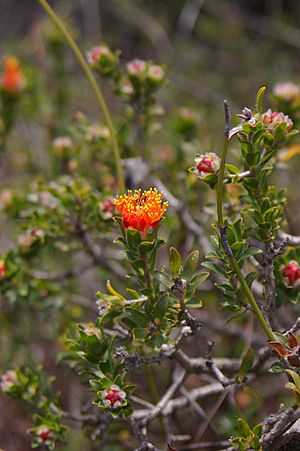Eremaea asterocarpa facts for kids
Quick facts for kids Eremaea asterocarpa |
|
|---|---|
 |
|
| In the Perth suburb of Southern River | |
| Scientific classification | |
| Genus: |
Eremaea (plant)
|
| Species: |
asterocarpa
|
| Synonyms | |
|
Melaleuca asterocarpa (Hnatiuk) Craven & R.D.Edwards |
|

The Eremaea asterocarpa is a cool plant from the Myrtaceae family, also known as the myrtle family. This plant is special because it only grows naturally in the south-west part of Western Australia. It's a type of shrub with wide, flat leaves and pretty orange flowers that bloom in late winter or spring. You'll usually see just one flower at the end of a branch that grew the year before.
Contents
What Does Eremaea asterocarpa Look Like?
This plant is a shrub that can grow up to about 1.3 meters (or 4.3 feet) tall. It can look different depending on where it grows. Some plants are low and spread out, while others stand up straight or have short, twisted branches.
Leaves and Flowers
The leaves of the Eremaea asterocarpa are small, usually between 3.4 and 8.3 millimeters long (about 0.13 to 0.33 inches). They are also 1.0 to 4.5 millimeters wide (about 0.04 to 0.18 inches). Their shape is like an oval or an egg, with the narrower part closer to where they attach to the stem. If you look closely at the bottom of the leaves, you can see 5 to 7 tiny lines, which are veins.
The flowers are a bright orange color. They usually grow one by one, or sometimes two together, at the ends of branches that grew in the previous year. Each flower has 5 sepals, which are small leaf-like parts that protect the flower bud. These sepals are quite hairy on the outside. There are also 5 petals, each about 4 to 6 millimeters (0.16 to 0.24 inches) long.
The bright orange color of the flower comes from its stamens. These stamens are grouped into 5 bundles, and each bundle can have between 16 and 36 stamens!
Fruits and How to Spot This Plant
Eremaea asterocarpa flowers from July to November. After the flowers fade, they turn into woody capsules, which are like small seed pods. These capsules are about 6.9 to 8 millimeters (0.27 to 0.31 inches) long. They are shaped a bit like a cup and feel rough and lumpy. The cool thing is that the remains of the sepals stay on the end of the fruit, making it look like a little star!
You can tell this plant apart from other similar plants by its rough fruits and by looking for 5 or more veins on its leaves.
Plant Naming and Types
The scientific name Eremaea asterocarpa was first officially described in 1993 by a scientist named Roger Hnatiuk.
The second part of the name, asterocarpa, comes from two old Greek words. Astḗr means "a star," and karpós means "fruit." This name perfectly describes the star-like pattern you can see on the end of the fruit.
There are three slightly different types, or subspecies, of Eremaea asterocarpa:
- Eremaea asterocarpa asterocarpa: This type has leaves with 3 (or sometimes 5) veins.
- Eremaea asterocarpa subsp. histoclada: This plant grows upright with straight or slightly curved branches. Its leaves have 5 to 7 or more veins.
- Eremaea asterocarpa brachyclada: This is a small, low shrub with short, twisted branches. Its leaves also have 5 to 7 or more veins.
Where Eremaea asterocarpa Grows
You can find Eremaea asterocarpa growing in areas close to the coast in the south-west of Western Australia. It lives in sandy soil that is often found over a type of rock called laterite. It grows in specific natural areas known as the Geraldton Sandplains, Jarrah Forest, and Swan Coastal Plain.
Conservation Status
The good news is that the Western Australian Government's Department of Parks and Wildlife has classified Eremaea asterocarpa as "not threatened." This means it's not currently in danger of disappearing.


